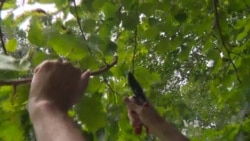For almost 15 years, environmental activist Patterson Clark has been one of the U.S. National Park Service volunteers who go through forests and remove invasive plants. Because he knew how destructive these plants can be, killing their native host trees, increasing soil erosion, and causing major damage to streams and other wetland areas, Clark had already developed an antagonistic relationship with them.
“One day, when I was pulling a plant, I thought, how can I change my relationship with this plant so it’s not just eradication, taking something's life?,” he wondered. “Since then, I’ve been harvesting plants, rather than just killing them. Some people who volunteer to pull weeds are called warriors. I don’t consider myself a warrior, I’m more of a gatherer.”
The artist, graphic editor and self-described "weed gatherer" now gives these plants a new life.
“When I first work with a plant, I call that prospecting," he said. "I’ll sit with the plant, study its nature, cut it, bring it back into the studio, and then start running tests on it to see if it’s good for pigment [or] paper [or] other kinds of fiber.”
White mulberry produces paper
Over the years, Clark has developed a fondness for some of the weeds, like white mulberry.
“It offers paper, the strongest, whitest paper, pretty good lumber, fuel, [and] ash from that fuel is used to create a chemical used to break down the inner bark to make paper,” he says.
That's a multistep process that takes long hours of work, and a lot of patience. Clark estimates it takes 20 minutes to cut down the plant, 30 minutes to steam it, five minutes to strip the bark, three hours to scrape it, an hour to cook it, 20 minutes to wash it and another hour to beat it. Then, he molds the sheet and lets it dry overnight. He's rewarded with a stack of unique papers that have become art.
Bushes offer colors
Clark extracts the inks he uses in his paintings and prints from a variety of invasive vines and bushes.
“I take some ivy leaves and put them in ethanol,” he explains. “That’s how we get the green ink. Multiflora rose, the stems give us red ink. Bush honeysuckle, the inner bark provides an aqua color. And the leatherleaf mahonia, the inner bark of that, put it in ethanol, creates a fluorescent yellow color.”
Each print Clark creates includes all the plants he's collected.
“I also include the landscape where these plants came from," he says. "Sometimes I will include a volunteer pulling plants, or a tool used to process the plants, but all of these are part of the design.”
Creating art
Clark uses a computer to create his designs.
“I still use digital techniques in this work to expedite the process. Any tool or device that allows me to consume more weeds is good in my book," he says. "The more weeds I consume, the more space I create for the return of native plants and native animals. So, it’s an environmental practice.”
He cuts his design into a block of wood by laser. Then, he applies his plant-based ink onto the block and presses it onto the handmade paper, repeating the process for each color.
Clark also makes frames for his prints from foraged plants, which attracts a lot of attention and admiration when he shows them in art exhibits.
“I do appreciate the compliments," he admits, "but one thing I have heard some concern about is the archival quality of these prints. Some of the pigments that I use will last for a long time. Some of the brighter colors, however, if put in really bright light, will eventually fade a little bit. So, I encourage people who buy a print to put it in low light or keep it in a folio. That’s how I’d like these things to be treated.”
With his artistic treatment of invasive species, Patterson Clark is turning them into something that is actually valued.









